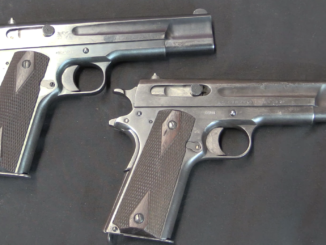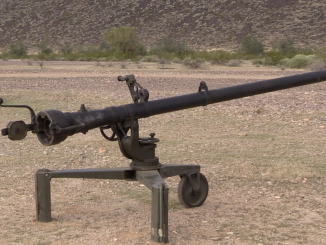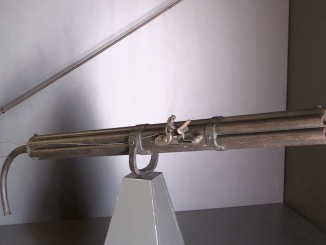Everyone is aware of the Mosin Nagant rifle, but not everyone realizes that about 2 million of them were actually manufactured in the United States. Russia had been producing M91 Mosin Nagant rifles in their three major arsenals (Tula, Izhevsk, and Sestroyesk) since the mid 1890s, but when World War One broke out that found themselves desperately short of arms. A government study determined that 17 million rifles would be necessary for a 3-4 year war, and they began the conflict with “just” 4 million in inventory.
One of the solutions to address this shortage was to contract production from factories outside the country. Using preexisting industrial connections (mostly from the railway sector), Russian official arranged for rifle production from the Remington and Westinghouse companies. Westinghouse had not even been in the arms industry before the war, and actually created a new subsidiary (called New England Westinghouse) to take on the jo, purchasing the J. Stevens and A.H. Fox gun companies to get the necessary infrastructure and expertise.
In total, about 2 million Mosins were manufactured by these companies before the Russian Revolution ended the arrangement. After the fall of the Czar, remaining production was purchased by the Kerensky white government, and buy the United States government, as a way to bail out the companies. The examples of these American M91s we have today in the US (including the Westinghouse gun in this video) are primarily imported from Finland, where large numbers were captured and bought after the Revolution and up until World War Two. The Remington example in this video, however, is a beautiful specimen that was purchased by the US government and never shipped abroad.




“Mosin Nagant rifles in their three major arsenals (Tula, Izhevsk, and Sestroyesk) since the mid 1890s”
Additionally 500’000 were ordered from Manufacture Nationale d’Armes de Châtelleraut (France)
“found themselves desperately short of arms”
So Fyodorov (of Fyodorov Avtomat fame) was sent to find possible sources of rifles (several years later he wrote “В поисках оружия” about that time), he summed that such blend was good for learning history of rifles, but not for waging war.
“egan the conflict with “just” 4 million in inventory”
So any rifle available was accepted, Fyodorov wrote in above-mentioned book about among others: 450’000 single-shot Gras model of 1874 (from France), 105’000 Gras-Kropatschek model of 1874-1885 years with 8-round underbarrel magazine (from France), 400’000 Vetterli model of 1870-1877 years with 4-round maganize (from Italy), 39’000 Lebel model of 1886-1907 years (from France), 60’000 Japanese Arisaka model of 1905 years (from Royal Navy, which replace Arisaka with Lee-Enfield)
“government study determined that 17 million rifles”
Fyodorov – http://militera.lib.ru/memo/russian/fedorov_vg/03.html – states that:
there should be 4559003 rifles and carbines for mobilization, formally were: 4652419, however estimated losses were 200000/month, however more man were mobilized than planned – there was lack of rifles for them, so conscripts were trained with rifle-shaped wooden planks. The planned production rate was 60000/month, but it can be realized. This was caused due to fact that Russian rifle factories were running fast only when forces were swapping rifle for new model or during war – in 1914 Tula Plant (biggest factory in Russian Empire!) produced:
Month: Rifles
January: 5, literally: FIVE
February: 5
March: 6
April: 5
May: only 1
June: 1
July: 1 training rifle
So summing up: shortly before outbreak of war Ministry of War was so incredible reading to war, so biggest factory 1 TRAINING rifle during one month.
Anyway workers of armament plants were called into service.
Combat experience shows that no less than 200000/month should be supplied to front. Rifle factories running at full speed can’t produce more than 525000/year, some like 1/5 of needed refill. Arisaka rifles originally destined for rear-echelon troop were sent to front, 300000 rifle – but what mean 300000 once, when there were needed 200000/month? So search of weapons started.
You can’t make rifles if your workers were sent to the front to die. One must wonder if the Tula plant received enough steel and tooling for mass production. One must also wonder if any remaining workers got paid enough for their services.
“One of the solutions to address this shortage was to contract production from factories outside the country.”
However, it should be noted that not only Russian Government underestimated war matériel needs, see Shell Crisis (Great Britain): https://en.wikipedia.org/wiki/Shell_Crisis_of_1915
“Remington”
During First World War also produced rifle (Pattern 1914) for Great Britain:
https://en.wikipedia.org/wiki/Pattern_1914_Enfield
It’s always a bit surprising to me that even under the desperate press of war these rifles are such examples of exotic machine work. All those just so curves cost a fortune in machine and labour time, yet no one said that a plain cylindrical shape would do for the forend, and you can leave the back third of the butt square.
“All those just so curves cost a fortune in machine and labour time, yet no one said that a plain cylindrical shape would do for the forend, and you can leave the back third of the butt square.”
But applying alterations to design cost time, so apparently blueprints were delivered “as-is” rather than simplified (which would probably start discussion what can be omitted and what not, so more time needed)
As I recall, quantities of these rifles were issued to U.S. troops participating in the Allied missions to guard war materiel shipped to Russia before the Bolshevik Revolution.
The battalion in which I served in Korea, 1/31st Infantry (Mechanized), was part of one of the regiments sent to Russia. I believe that there are pictures of troops from the 31st Infantry serving in Russia, armed with U.S. made Mosin-Nagant rifles.
Link haze and confusion:
Dead link: as I type this, the link under the text “manufactured in the United States” is trying to go to lot 6308, which doesn’t exist in this auction.
The Remington Mosin Nagant with serial number 514609 is in lot 2553, at https://www.rockislandauction.com/detail/1028/2553 .
There are three Westinghouse Mosin Nagants: serial number 1304286 in lot 2457, 977478 in lot 6317 (specifically noted to have a barrel dated 1915 and with “a Finnish `SA’ capture mark”), and 124405 in lot 6380. I can’t find 553895 anywhere.
The lack of Finnish modifications might indicate that the Westinghouse was captured during WW2 in good condition and then used either directly by the soldier who captured it, or re-issued after a quick checkup at the depot. Even in 1941 the Finnish Army still had a shortage of Mosin-Nagants. Modifications and rebuilds to M39 standard were typically done to rifles with broken stocks or other issues, while good ones were used “as is”.
What about Russian Provisional Government (existed from february through october of 1917)? They were pretty much pro war, Pavel Milyukov (Foreign Minister) in particular.
One of the recent books on the AK47 had a lot of background about the staggering logistics involved in keeping a huge army in adequate small arms. I can’t recall if it was Hodges or Kahaner.
The point of all that was the significance of design that actually COULD be produced at the speed needed for the kind of ‘full continent’ armed forces that the USSR and China needed to equip.